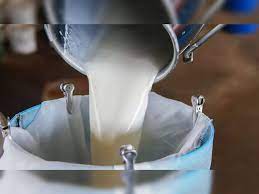Will the improved raw milk supply cause dairy inflation to ease in the next months?
As a result of a sharp increase in the price of vegetables throughout the nation, CPI inflation soared to 7.44 percent in July. Dairy product prices are being continuously monitored as pressure on CPI inflation remains high. Dairy inflation moved in the other way as retail inflation decreased from 7.79% in April of last year to 4.25% in May of 2023.
The official figures show that in July of last year, the inflation rate for milk and other items was 5.78%. Dairy prices have increased significantly since then, with the inflation rate reaching a high of 9.65 percent in February of this year. In July, the inflation rate for milk and other items was 8.34%.
The percentage was consistent between April and July, ranging between 8 and 9 percent. Dairy inflation marginally decreased from 8.85% in May to 8.34% in July, whereas the CPI inflation rate increased from 4.25% in May to 7.74% in July. Prices of dairy products have been rising for a while due to a number of supply chain-related concerns.
Pressure From Inflation on Dairy Products
According to Sheetal Sharad, vice president at ICRA Ltd, when discussing the increased costs of dairy products in the financial year 2023, “Domestic raw milk availability was impacted in FY2023 owing to the incidence of lumpy skin disease and erratic weather affecting milk productivity, particularly in northern and western states of the country. In addition, the cost of fodder and feed for dairy farmers was considerable. From 7.14 percent in January 2022 to 29.30 percent in January 2023, the annual rate of inflation for feed increased. Analysts claim that this directly affects milk prices.
Dairy firms had to spend more on procurement as a result of the supply problems, which increased retail prices. Data from market analytics company CRISIL show that dairy producers increased their prices by a total of Rs 5-7 per litre during the previous fiscal year. The business claimed in its report that supply chain interruptions were caused by both changes in the artificial insemination timetable and changes in the price of feed.
Analysts claim that the supply chain problems have abated, which means that this fiscal year will see less increases in milk prices. Anand Kulkarni, director at CRISIL Ratings, stated in a statement that “milk price hikes will be much less intense this fiscal at around Rs 2 per litre compared with a cumulative Rs 5-7 per litre last fiscal, primarily because of two reasons—improvement in raw milk supply on better availability of fodder, and timely vaccination and artificial insemination of cattle.”
In response to a question on the cost of raw milk this fiscal year, Sharad said, “We anticipate raw milk prices to steadily decline as milk supplies in the southern states recover throughout the flush season. We anticipate that the northern flush season will provide similar results, bringing down the price of raw milk.
Experts on the topic are concerned about whether the growing supply would significantly lower dairy inflation in the next months.
Continued worries
The chief economist and director of research at Acuite Ratings, Suman Chowdhury, said that the problems with the supply chain had not totally disappeared. Due to the unpredictable monsoon pattern and high feed costs, there are still worries. He predicted that if milk prices are raised, dairy inflation might rise from its present levels and stay in the 7-8% area.
In the most recent financial year, the average WPI inflation rate for feed costs was 21%, according to data gathered by CareEdge ratings. The average has significantly decreased, although between April and July of FY24 it was 10%, still in the double digits. Additionally, up until the end of last month, the irregular monsoon pattern had caused surplus rainfall in several states, including Punjab, Rajasthan, and Gujarat, while Jharkhand, West Bengal, and Bihar were among those that saw deficient rainfall.
Dairy inflation is continuing under pressure, according to Shambhavi Priya, an associate economist at CareEdge Ratings, due to supply-demand imbalances and high input costs. She said, “With the likelihood of an increase in milk output, some moderation may be observed from Q3 forward. Flush season for milk is often defined as the time between October and March when there is a naturally occurring rise in milk output. An unfavorable monsoon, however, might be a spoilsport by affecting the output of crops used as cow fodder and maintaining high input costs.
Although input costs are still high, they have decreased throughout the course of this fiscal year. Experts are unsure, however, if dairy firms would pass the gains on to customers. Sharad said that there is now little chance of significant price reductions. It is still to be seen how the increase in the availability of raw milk would impact the costs of dairy products in the next months given the uncertainty surrounding the monsoon and the high cost of fodder.







